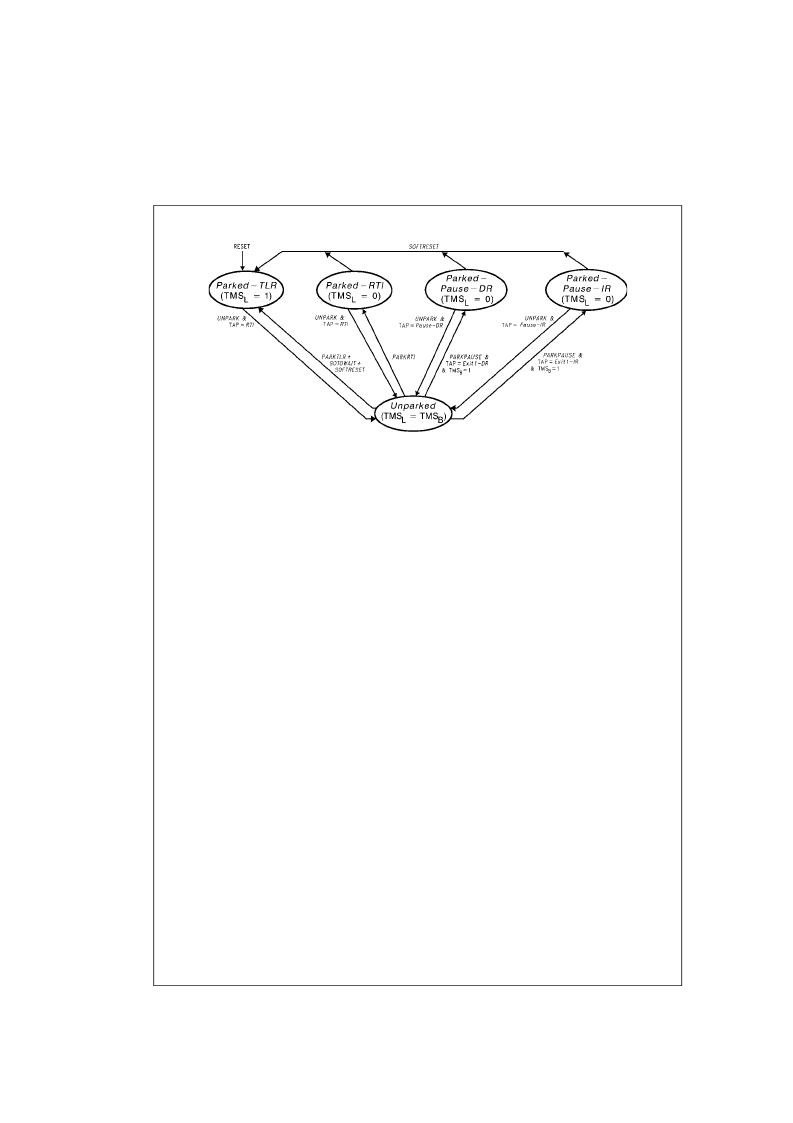- 您現(xiàn)在的位置:買賣IC網(wǎng) > PDF目錄383804 > SCANPSC110FSC (FAIRCHILD SEMICONDUCTOR CORP) SCAN Bridge Hierarchical and Multidrop Addressable JTAG Port (IEEE1149.1 System Test Support) PDF資料下載
參數(shù)資料
| 型號: | SCANPSC110FSC |
| 廠商: | FAIRCHILD SEMICONDUCTOR CORP |
| 元件分類: | 微控制器/微處理器 |
| 英文描述: | SCAN Bridge Hierarchical and Multidrop Addressable JTAG Port (IEEE1149.1 System Test Support) |
| 中文描述: | SPECIALTY MICROPROCESSOR CIRCUIT, PDSO28 |
| 封裝: | 0.300 INCH, MS-013, SOIC-28 |
| 文件頁數(shù): | 6/25頁 |
| 文件大?。?/td> | 283K |
| 代理商: | SCANPSC110FSC |

www.fairchildsemi.com
6
S
Overview of SCANPSC110F Bridge Functions
(Continued)
FIGURE 4. Local SCANPSC110F Bridge Port Configuration State Machine
The SCANPSC110F
’
s scan port-configuration state-
machine is used to control the insertion of local scan ports
into the overall scan chain, or the isolation of local ports
from the chain. From the perspective of a system
’
s (single)
scan controller, each SCANPSC110F presents only one
scan chain to the master. The SCANPSC110F architecture
allows one or more of the SCANPSC110F
’
s local ports to
be included in the active scan chain.
Each local port can be
“
parked
”
in one of four stable states
(Parked-TLR, Parked-RTI, Parked-Pause-DR or Parked-
Pause-IR)
, either individually or simultaneously with other
local ports. Parking a chain removes that local chain from
the active scan chain. Conversely, a parked chain can be
“
unparked
”
, causing the corresponding local port to be
inserted into the active scan chain.
As shown in Figure 4, the SCANPSC110F's three scan
port-configuration state-machines allow each of the part's
local ports to occupy a different state at any given time. For
example, some ports may be parked, perhaps in different
states, while other ports participate in scan operations. The
state-diagram shows that some state transitions depend on
the current state of the TAP-control state-machine. As an
example, a local port which is presently in the
Parked-RTI
state does not become unparked (i.e., enter the
Unparked
state) until the SCANPSC110F receives an
UNPARK
instruction
and
the SCANPSC110F's TAP state-machine
enters the
Run-Test/Idle
state.
Similarly, certain transitions of the scan port-configuration
state-machine can force the SCANPSC110F's TAP-control
state-machine into specific states. For example, when a
local port is in the
Unparked
state and the SCANPSC110F
receives a PARKRTI instruction, the Local Port controller
enters the
Parked-RTI
state in which TMS
Ln
will be held
LOW until the port is later unparked. While TMS
Ln
is held
LOW, all devices on that local scan chain remain in their
current TAP State (the
RTI
TAP controller state in this
example).
The SCANPSC110F's scan port-configuration state-
machine implements part of the SCANPSC110F's Level-2
protocol. In addition, the SCANPSC110F provides a num-
ber of Level-2 instructions for functions other than local
scan port configuration. These instructions provide access
to
and
control
of
various
SCANPSC110F. This set instructions includes:
registers
within
the
Figure 5 illustrates how the SCANPSC110F's state-
machines interact. The SCANPSC110F-selection state-
machine enables or disables operation of the chip's three
port-selection state-machines. In SCANPSC110Fs which
are selected via Level-1 protocol (either as individual
SCANPSC110Fs or as members of broadcast or multi-cast
groups), Level-2 protocol commands can be used to park
or unpark local scan ports. Note that most transitions of the
port-configuration state-machines are gated by particular
states of the SCANPSC110F's TAP-control state-machine,
as shown in Figures 4, 5.
BYPASS
EXTEST
SAMPLE/PRELOAD
IDCODE
MODESEL
MCGRSEL
LFSRSEL
CNTRSEL
LFSRON
LFSROFF
CNTRON
CNTROFF
GOTOWAIT
相關(guān)PDF資料 |
PDF描述 |
|---|---|
| SCP-5453 | SOCKET,IC,16PIN,MACHINE TOOLED WIRE WRAP,0.3"WIDE,0.515"LEAD |
| SCP-6122 | POWER OPERATIONAL AMPLIFIER |
| SCS152 | HM Series Hermetically Sealed Basic Switch, Single Pole Double Throw Circuitry, 0.5 A at 28 Vdc, Integral Lever Actuator, Solder Termination |
| SCS152-IS | Small glass bead with axial leads |
| SCS152-IW | Small glass bead with axial leads |
相關(guān)代理商/技術(shù)參數(shù) |
參數(shù)描述 |
|---|---|
| SCANPSC110FSCX | 功能描述:特定功能邏輯 SCAN JTAG Port RoHS:否 制造商:Texas Instruments 產(chǎn)品: 系列:SN74ABTH18502A 工作電源電壓:5 V 封裝 / 箱體:LQFP-64 封裝:Tube |
| SCANSTA101 | 制造商:NSC 制造商全稱:National Semiconductor 功能描述:Low Voltage IEEE 1149.1 STA Master |
| SCANSTA101_06 | 制造商:NSC 制造商全稱:National Semiconductor 功能描述:Low Voltage IEEE 1149.1 STA Master |
| SCANSTA101SM | 功能描述:接口 - 專用 RoHS:否 制造商:Texas Instruments 產(chǎn)品類型:1080p60 Image Sensor Receiver 工作電源電壓:1.8 V 電源電流:89 mA 最大功率耗散: 最大工作溫度:+ 85 C 安裝風格:SMD/SMT 封裝 / 箱體:BGA-59 |
| SCANSTA101SM/NOPB | 功能描述:接口 - 專用 Low Vltg IEEE 1149.1 Sys Test Access RoHS:否 制造商:Texas Instruments 產(chǎn)品類型:1080p60 Image Sensor Receiver 工作電源電壓:1.8 V 電源電流:89 mA 最大功率耗散: 最大工作溫度:+ 85 C 安裝風格:SMD/SMT 封裝 / 箱體:BGA-59 |
發(fā)布緊急采購,3分鐘左右您將得到回復(fù)。